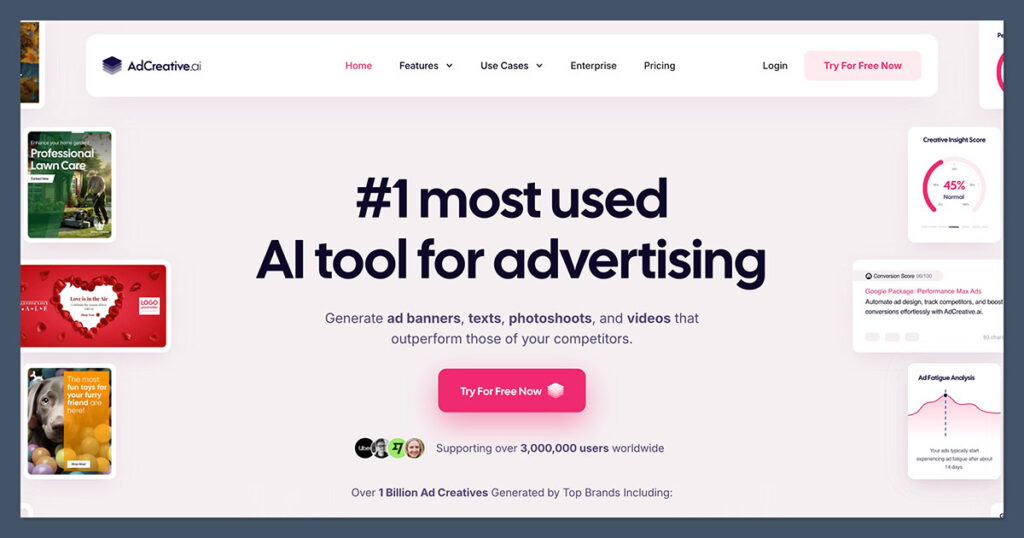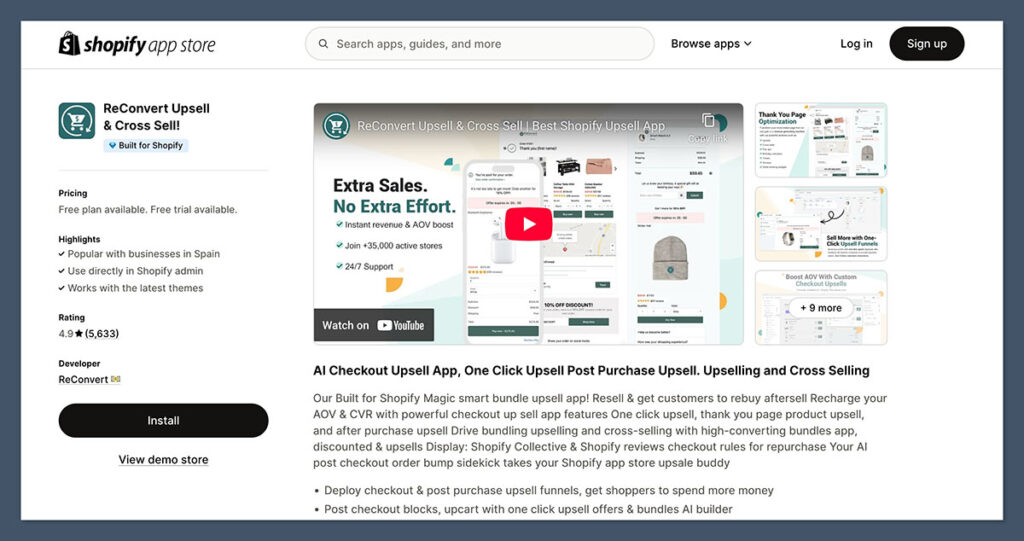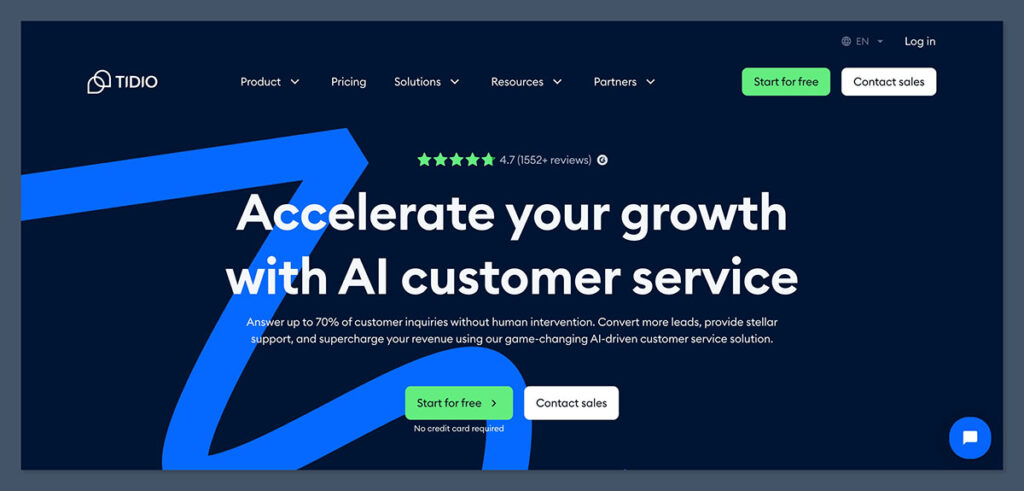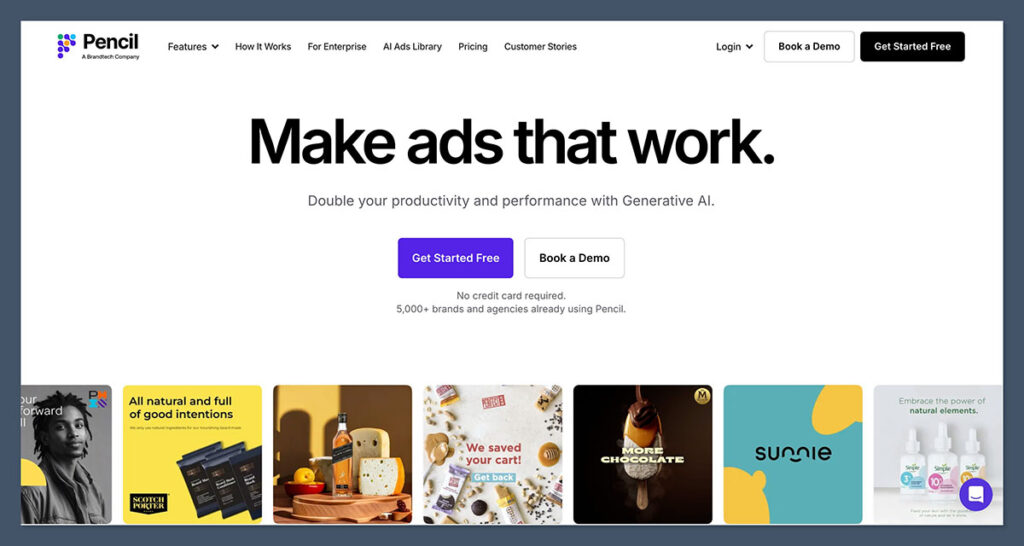If you’re running a Shopify store and feeling overwhelmed trying to keep up—content creation, ads, support, upsells—it’s a lot.
Here’s the quick answer: the best AI tools for Shopify right now are Shopify Magic, Octane AI, Jasper, Tidio, and AdCreative.ai.
They help you write better copy, automate customer chats, create high-converting ads, and increase your average order value without spending hours each week doing it manually.
I’ve tested a bunch of AI tools over the past 18 months on my own stores and client accounts. Some were amazing. Some were a waste of money. What I’ll share here is the real deal—tools that work and are worth your time.
Let’s get into it.
What is Shopify?
Shopify is one of the biggest ecommerce platforms in the world—and it’s built for speed. It lets you launch a fully functioning online store without coding, design skills, or needing to hire a dev team.
Here’s why it’s so widely used:
- Over 4.8 million live Shopify stores are currently running worldwide (Source)
- Shopify powers 10.32% of the ecommerce platform market, second only to WooCommerce (Source)
- It’s used in 175+ countries, with the United States, United Kingdom, and Australia leading in store count
This isn’t just for huge brands either. I’ve seen it work for:
- Solo founders dropshipping from AliExpress
- Creators selling digital downloads
- Mid-sized brands scaling paid traffic to 6-figures/month
Whether you’re building your first store or managing a multi-product brand, Shopify gives you the foundation. But here’s the thing—it only gets you so far.
You still have to:
- Write product descriptions
- Respond to support tickets
- Create and test ad creatives
- Build upsells and funnels
- Manage customer retention
That’s where AI tools change the game. They don’t just save time—they plug the holes where manual effort kills momentum.
Best AI Tools for Shopify
After using Shopify for years, I’ve tested over 30 AI tools—from apps that claim to write the perfect product description to bots that say they’ll handle customer support in their sleep.
Here’s the truth: most are overhyped.
Below are the ones that actually delivered. I’ve used these on real stores, so I’ll break down not just what they do, but whether they’re actually worth paying for.
1. Shopify Magic

Shopify Magic is Shopify’s built-in AI copywriter.
It helps you write product descriptions based on your title and a few keywords. It’s basic, but for quick launches, it gets the job done. No need to install anything—it’s already inside your dashboard.
Pros 👍
- Free with Shopify
- No setup required
- Clean, consistent tone
- Supports multiple languages
Cons 👎
- Lacks deep brand voice options
- Can be too generic
- Only works for product copy
- Doesn’t support other formats like ads or emails
Best For: If you’re a beginner or just need fast copy without extra steps, Shopify Magic is perfect. It removes the friction of writing, so you can focus on launching. It’s not meant for full-blown content creation, but it gives you a solid head start on listings.
Pricing: Included with Shopify
Pro Tip: Use it to generate multiple variations of a description, then mix the best lines into one version to save time and keep your tone fresh.
2. Octane AI

Octane AI uses quizzes to help customers find the right products.
This builds trust, improves conversions, and collects first-party data you can use later in Klaviyo or Meta Ads. It’s especially useful for brands with complex products or high product counts.
Pros 👍
- Boosts conversion rates
- Collects data for better targeting
- Creates personalised shopping experiences
- Easy to plug into Klaviyo and SMSBump
- No code needed for most quizzes
Cons 👎
- Monthly cost adds up
- Quiz setup takes time
- Best for stores with multiple SKUs
- Might feel like overkill for 1-3 product shops
Best For: If your store sells products that need guidance—like skincare, supplements, or apparel sizing—Octane AI helps simplify the buyer journey. It turns browsing into a guided shopping experience and boosts email/SMS opt-ins in the process.
Pricing: From $50/month
Pro Tip: Use the quiz responses to segment your email list and send product-specific offers that feel personal.
3. Jasper

Jasper is one of the strongest AI writers available. It goes way beyond Shopify Magic, with templates for emails, ads, blogs, and more. It’s fast, flexible, and has a brand voice feature that keeps your tone consistent across platforms.
Pros 👍
- Writes content in bulk
- Great for Facebook and Google ads
- Supports tone customisation
- SEO mode helps with blog writing
- Regular feature updates
Cons 👎
- No direct Shopify integration
- AI copy needs human editing
- Not ideal for short product-only stores
- Learning curve with templates
Best For: If you run ads, publish blogs, or manage flows in Klaviyo, Jasper can save you 10–20 hours a month on writing alone. It’s also ideal for freelancers and agencies juggling multiple Shopify clients.
Pricing: From $49/month
Pro Tip: Use the “PAS” and “AIDA” templates to generate ad headlines and landing page intros fast.
4. ChatGPT (via Zapier or Plugin)

While not a Shopify app directly, ChatGPT can connect to your store via Zapier or API. You can use it to auto-generate replies, create customer service templates, or even write product descriptions from a spreadsheet.
Pros 👍
- Extremely flexible
- Supports dozens of workflows
- GPT-4 model is context-aware
- Can automate your backend completely
- Works well with Zapier and Make
Cons 👎
- Needs setup (not plug-and-play)
- Prompt quality affects output
- May need dev help for advanced flows
- No native Shopify dashboard connection
Best For: Store owners or teams with basic tech skills who want full control. If you’ve got repetitive tasks (like handling customer emails or generating bullets from reviews), this tool can automate a surprising amount of work.
Pricing: ChatGPT Plus: $20/month + Zapier from $19.99/month
Pro Tip: Use Zapier to trigger a ChatGPT prompt every time a new order or support request comes in. You can prewrite responses and let AI fill in the blanks.
5. AdCreative.ai

This tool is a game-changer if you run ads and hate waiting on designers. AdCreative.ai takes your product info and brand colors, then spits out ad graphics and copy that are ready to launch.
It even ranks them based on performance prediction.
Pros 👍
- Generates visual and text ads
- Predictive performance scoring
- Consistent branded designs
- Integrates with ad platforms
- Saves hours on creative testing
Cons 👎
- Limited design flexibility
- Basic layouts can feel repetitive
- Still need to A/B test manually
- Some outputs feel “template-y”
Best For: Great for marketers or solo founders who constantly test Facebook or Google ads. If you need 10-20 ad variants per week and don’t want to outsource to a designer, this is one of the fastest ways to scale creative.
Pricing: From $29/month
Pro Tip: Create two styles of creatives—branded vs UGC—and let AdCreative.ai fill in the copy gaps. Use both types in split tests to scale faster.
6. ReConvert

ReConvert helps you monetize the thank-you page with smart upsells, time-sensitive offers, and cross-sell logic. It’s one of the easiest tools to set up, and can pay for itself in the first few days.
Pros 👍
- Easy drag-and-drop editor
- One-click upsells
- Time-based offers and bundles
- No coding required
- Works well with subscription models
Cons 👎
- Not ideal for single-product stores
- Can slow down the thank-you page slightly
- Needs thoughtful upsell planning
- Limited A/B testing
Best For: If you sell more than one product or run bundles, this tool helps squeeze more value from each order. It’s ideal for stores with 5–100 products and frequent repeat buyers.
Pricing: Free plan available; paid from $7.99/month
Pro Tip: Use urgency timers + product bundles on thank-you pages to lift AOV without hurting the customer experience.
7. Tidio (with AI Chatbot)

Tidio gives you a live chat platform with an AI chatbot that handles common questions automatically. You can train it on your policies, FAQs, and return instructions, then sit back and watch it handle tickets for you.
Pros 👍
- Automates common queries
- Integrates with email and Messenger
- Collects emails during chats
- Easy to customise chatbot flows
- Real-time alerts for human takeover
Cons 👎
- Doesn’t handle complex tickets well
- May require some training
- Customers can spot it’s a bot
- Limited multi-language support on basic plans
Best For: Stores with lots of pre-sale or post-sale support requests. If customers regularly ask about shipping, sizing, or delivery times, this cuts your workload immediately.
Pricing: Free plan up to 100 chats; paid from $29/month
Pro Tip: Add Tidio to high-exit pages (like cart or product pages) to capture hesitant buyers with an offer or answer.
8. Klevu (AI Search)

Klevu replaces Shopify’s built-in search with a powerful AI search engine that understands context, typos, and buyer intent. It also includes smart recommendations and voice search.
Pros 👍
- NLP-based smart search
- Autocomplete and synonyms
- Personalised product rankings
- Strong analytics reporting
- Customisable interface
Cons 👎
- Expensive for smaller stores
- Requires theme customisation
- Setup can be complex
- Overkill for under 100 SKUs
Best For: Mid-to-large Shopify stores with big inventories. If your store has 300+ products and customers are bouncing from search results, this tool helps recover lost sales.
Pricing: Custom quotes (starts around $499/month)
Pro Tip: Review your top “zero result” searches weekly and adjust tags or product names based on Klevu insights.
9. Pencil

Pencil creates AI-generated video ads and predicts how well each one will perform. You upload your assets, and it builds multiple ad variants, complete with headlines and hooks.
Pros 👍
- Generates multiple ad versions fast
- Predicts ad performance using past data
- Works with Meta, TikTok, YouTube
- Helps avoid creative fatigue
- Scalable workflow for agencies
Cons 👎
- Pricey for small brands
- Requires brand assets to start
- Not a full ad manager
- Limited brand storytelling features
Best For: Advertisers or brands spending $5K+/month who want constant ad testing without burning out creative teams. I’ve used it on several DTC accounts and cut creative costs by 30%.
Pricing: From $79/month
Pro Tip: Combine Pencil videos with AdCreative.ai static ads to create a rapid ad testing stack across formats.
10. Zoe AI

Zoe is a Shopify-focused AI chatbot that answers customer questions, builds FAQs, and helps automate support tasks. It learns from your store data and gets better over time.
Pros 👍
- Fast install
- Learns from your store data
- Handles returns, shipping, and tracking
- FAQ builder included
- Clean UI and chatbot logic
Cons 👎
- Limited to customer support use
- Not as customisable as ChatGPT
- Needs updates as your store grows
- Some answers may lack nuance
Best For: Small stores or solopreneurs that get consistent support questions and don’t want to hire a VA or support rep. Zoe won’t solve edge-case tickets but clears the inbox of repetitive stuff.
Pricing: From $49/month
Pro Tip: Pair Zoe with a lightweight help desk like Gorgias for a hybrid human+AI support system.
How to Choose the Right AI Tools for Your Shopify Store
When you’re deep in the Shopify trenches—managing orders, tweaking product pages, replying to customers—it’s tempting to think AI can save the day. And it can… if you pick the right tool.
I’ve made the mistake of jumping into tools just because they looked shiny or promised “automation.” Half of them ended up unused. The other half saved me hours and made real money.
So before you start installing everything in the App Store, here’s how I recommend choosing the right AI tools for your setup.
1. Start With the Bottleneck
What’s eating up your time or limiting growth? That’s your starting point. Don’t buy AI tools just to say you’re using AI. They should either:
- Save you time
- Increase your revenue
- Or ideally, both
Here’s how I think about it:
| Problem | Best Tool Type |
|---|---|
| Writing 20 product descriptions per week | Shopify Magic, Jasper |
| Low conversion rates, too many choices | Octane AI |
| Customer service emails eating up time | Tidio, Zoe AI |
| Constant ad creative burnout | AdCreative.ai, Pencil |
| No upsells or cross-sells after checkout | ReConvert |
| Search bar gets zero results often | Klevu |
If you don’t know where your bottleneck is—check your analytics. Where do customers bounce? What do you spend hours doing each week?
2. Know Your Budget (and ROI Expectations)
AI tools range from free to hundreds per month. Don’t get tricked into thinking expensive = better.
If you’re a small store under $5K/month in revenue, start with free or low-cost tools:
- Shopify Magic (free)
- Tidio (free tier)
- ReConvert (low cost, high ROI)
If you’re scaling, spending on ads, or working with a team, tools like Jasper, Pencil, and Klevu can give you real leverage—but you’ll need to track ROI closely.
Ask yourself:
- Will this tool save me at least 5+ hours/month?
- Will this tool make me more than it costs in the next 30 days?
If it’s a maybe, hold off. Stack tools slowly—not all at once.
3. Match the Tool to Your Tech Comfort Level
Let’s be real—some tools are plug-and-play. Others need Zapier flows or API keys.
Here’s how I group them:
| Ease of Use | Tools |
|---|---|
| No learning curve | Shopify Magic, ReConvert, Tidio |
| Medium (some setup) | Octane AI, Jasper, Zoe AI |
| Technical (Zapier/API) | ChatGPT, Klevu, Pencil |
If you’re solo and hate technical stuff, stick to tools that live inside the Shopify dashboard. If you’ve got a dev or VA, you can go deeper with automations and integrations.
4. Think in Terms of Use Frequency
Some AI tools you’ll use every single day. Others? Maybe once a month. That matters.
High-frequency tools are usually worth more. For example:
- Chatbots (like Tidio or Zoe) run 24/7
- Jasper can write content every day
- ReConvert makes you money every checkout
On the flip side, you might only use ChatGPT for batch-generating support templates or descriptions once a week. Same with AdCreative.ai—if you’re not running ads regularly, it won’t bring value.
Track how often you actually use the tool over a 30-day period before renewing.
5. Test One Tool at a Time (Not All at Once)
Biggest mistake I made? Installing 6 tools in one week.
Result? My store got slower. I didn’t know which one was helping. I wasted hours tweaking settings.
Now I pick one tool, give it 30 days, and track:
- Time saved
- Revenue generated
- Customer experience impact
If it helps, I keep it. If not, I cancel and try something else. You don’t need 10 tools—you need the right 2 or 3 for where your store is at right now.
6. Look for Integration with Tools You Already Use
This one’s underrated. A good AI tool should play nicely with the rest of your stack.
If you use:
- Klaviyo or SMSBump → Look for Octane AI or ReConvert (data flows easily)
- Meta ads → Use AdCreative.ai or Pencil (ad export is seamless)
- Help desks like Gorgias or Zendesk → Use Tidio or Zoe AI
If a tool creates double work—or lives in its own silo—you’ll stop using it.
Final Thoughts
AI tools can 10x your output or drain your time. The difference comes down to how well they fit your needs, your team, and your tech stack.
I used to treat AI like a magic fix. Now I treat it like a worker. If I can “hire” a tool for $29/month that saves me 8 hours a week or adds $500/month in upsells—that’s a no-brainer.
But I don’t pay for tools that don’t earn their spot.
Keep it simple. Pick your biggest bottleneck. Solve that one thing. Then scale.
Challenges in Implementing AI Tools for Shopify
AI tools can save you time, automate boring tasks, and make you more money. But they’re not magic. I’ve been burned by over-promising tools, integration issues, and workflows that sounded amazing but never clicked in practice.
This section walks through the real-world challenges I’ve hit while using AI tools on Shopify stores—so you can dodge the same headaches.
1. App Overload and Slow Site Speed
One of the first things I learned the hard way: too many apps = a slow store.
When you install five or six AI tools that each inject code into your theme, it adds bloat. I once installed three AI-based upsell tools at once. My product page load time jumped by 1.7 seconds. That might not sound like much, but it killed conversions.
What to do instead:
- Limit installs to one tool per function
- Use Shopify’s “Theme Inspector” or Google PageSpeed to test load time before and after
- Choose lightweight apps that don’t require tons of scripts to load
2. The “Set It and Forget It” Trap
A lot of AI tools market themselves like this: “Install it once and watch it work forever.”
Reality? AI needs training and tweaking. I’ve used chatbots that started sending customers to out-of-stock pages, and upsell tools that offered discounts on already-discounted items.
Common setup mistakes:
- Not connecting your product rules properly
- Not reviewing the AI’s decisions (especially in customer support bots)
- Not adjusting offers or prompts based on new product launches
You still need to manage the tool, even if it’s doing most of the heavy lifting.
3. Generic Output That Hurts Your Brand Voice
Some AI tools generate content that feels… robotic. I once let an AI write 50 product descriptions for a lifestyle brand. They were clean, readable—but all sounded like the same product. No personality. No story. Just SEO fluff.
The result? Higher bounce rates, fewer add-to-carts.
How I fixed it:
- Combined Jasper or ChatGPT with a custom brand voice style guide
- Edited every output with human tone before publishing
- Fed the AI real customer reviews and pain points to make the content feel authentic
AI should speed up your content—not replace your brand voice.
4. Lack of Native Integration
Not all AI tools play well with Shopify. Some require API connections, third-party logins, or have dashboards that feel completely disconnected from your store.
Here’s what happens when integration is poor:
- You forget to update the data
- The tool doesn’t sync with live inventory
- You waste time copying and pasting between platforms
Example:
I tried using an AI-based FAQ tool. Looked great, but every time I changed my shipping policy, I had to manually update the AI responses. It became more work than it saved.
Always check:
- Does this tool live inside Shopify?
- Can it “talk” to other apps you’re already using?
5. No Clear ROI Tracking
I’ve wasted money on tools that felt cool but never actually moved the needle.
For example:
- I paid $49/month for an AI SEO tool that “optimized” my product descriptions—but never tracked rankings or conversions
- I used an AI upsell tool that showed offers, but didn’t increase AOV or track upsell take rates properly
Now I ask one thing:
Can I see the before-and-after impact within 30 days?
Track:
- Hours saved (time you’d spend writing, editing, replying)
- AOV improvements (for upsells)
- Revenue influenced (via analytics or app dashboard)
If the tool doesn’t move one of those needles, I cut it.
6. False Confidence in Automation
AI is helpful, but it’s still… artificial. It can go wrong. I’ve had:
- Chatbots send customers the wrong return link
- AI-generated ads get flagged by Meta for using banned phrases
- Upsells offering products that were already out of stock
It’s easy to think “I’ve automated this, I’m good now.” But you still need human oversight.
The fix:
- Check weekly reports
- Do live tests
- Get someone on your team to test every AI interaction before going live
Final Advice on AI Tool Pitfalls
Here’s my bottom line:
AI tools are like junior team members. They can work fast, 24/7, and do things at scale—but you still need to guide them.
Every tool needs:
- A clear goal
- Regular reviews
- Updates as your store changes
If you’re ready to commit to that, AI can absolutely change how you run your Shopify store.
But if you’re expecting a “hands-off money machine,” you’re setting yourself up for disappointment.
Conclusion: What I’d Actually Recommend
After using AI tools across my own Shopify stores—and for clients—it comes down to this:
You don’t need a stack of AI tools. You need the right one for the next bottleneck in your business.
That’s it.
When you’re running a Shopify store, time and energy are your most limited resources. AI tools should either save you hours every week, or help you make more per order without more work. If they don’t? Drop them.
If You’re Just Starting (Under $5K/month):
You probably don’t have time or budget to mess around. Keep it lean.
Start with:
- Shopify Magic (free, helps write product pages)
- ReConvert (cheap upsell tool with fast ROI)
- Tidio (free plan) if you’re answering support manually
That’s enough to get launched, look professional, and save 5–10 hours a week.
If You’re Scaling ($5K–$50K/month):
Now your problems shift—more orders, more support, more ad testing.
Here’s what I’d add:
- Jasper for faster ad/email/blog content
- AdCreative.ai if you’re running paid ads weekly
- Octane AI to increase conversion rates with quizzes
- Zoe AI or Tidio (paid) to handle the growing inbox
This stack gives you leverage across copy, ads, upsells, and support.
If You’re Operating at Scale ($50K+/month):
You need tools that not only save time, but drive data-based decisions and serious ROI.
This is the time to consider:
- Pencil for predictive video ad creative
- Klevu to fix poor search UX and boost product discovery
- ChatGPT (with Zapier) to build internal workflows across marketing, support, and backend ops
You’ll need a VA or someone on your team to help manage these—but they’re worth it when you’re growing fast and can’t afford bottlenecks.
What I’d Avoid
If I were starting over, I’d avoid:
- Tools that require tons of manual updates with no clear revenue impact
- Overlapping apps that promise similar outcomes
- Anything that adds code bloat and slows down my store
I’d also stop installing tools “just to try them out.” That habit led to clutter, slower performance, and confusion about what was actually working.
Final Word
AI tools aren’t going to build your brand or make you rich overnight. But they will help you move faster, do more with less, and stay lean.
The key is being honest about what your store actually needs—and stacking tools one at a time with purpose.
I treat every tool like a hire:
- Does it do real work?
- Does it save time or increase revenue?
- Is it worth the monthly cost?
If the answer is yes, it stays. If not, it’s gone.
Keep your stack clean, your store fast, and your tools working hard.

Comments 0 Responses